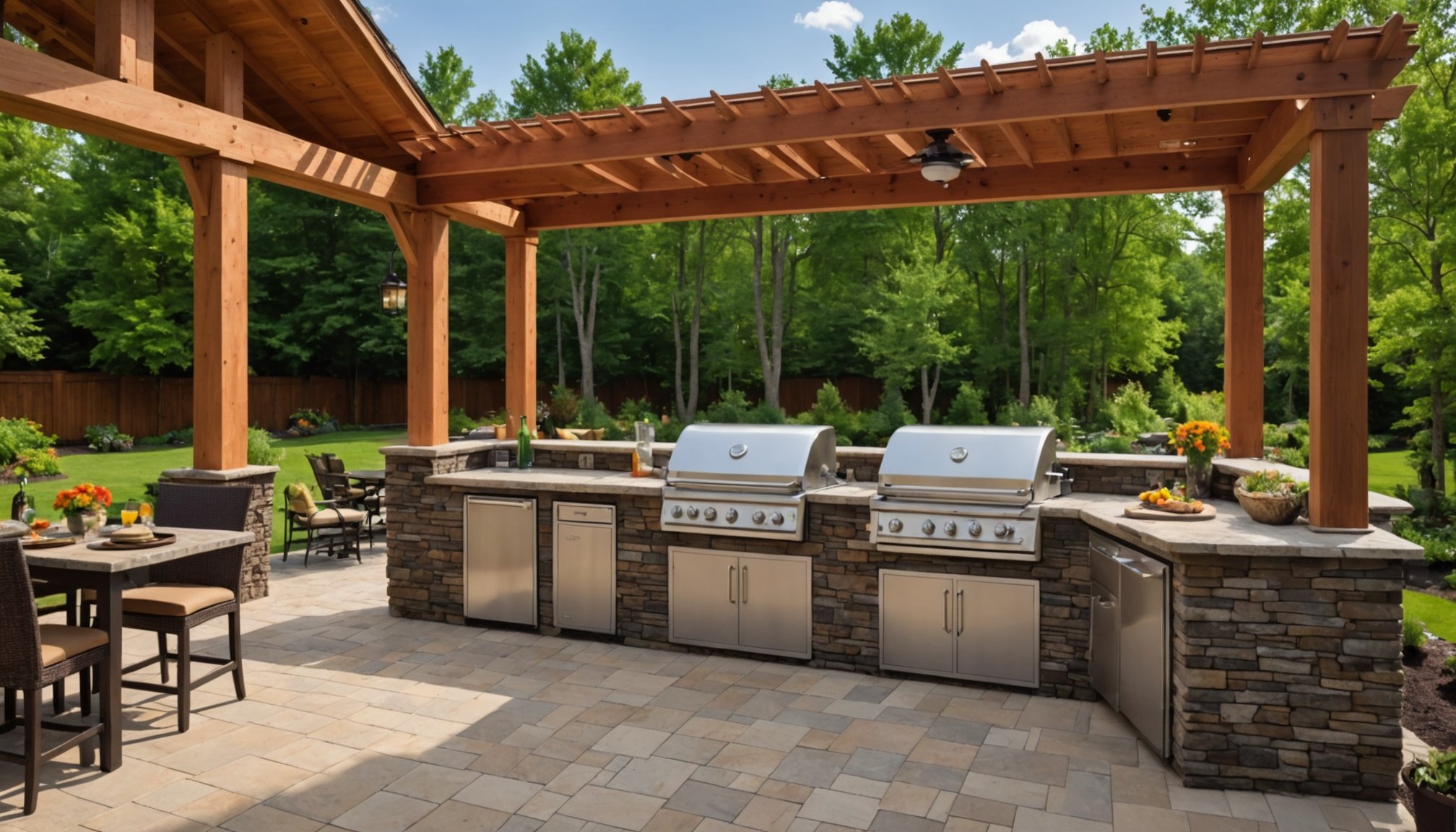Designing the Perfect Indoor-Outdoor Kitchen Layout
Creating an indoor-outdoor kitchen design that serves both functional and aesthetic purposes can significantly enhance your entertaining spaces. Seamless transitions between these areas are essential for achieving the perfect kitchen layout. This not only elevates the visual appeal but also improves the flow and utility of the space.
Key layout considerations include the alignment of indoor and outdoor appliances and workspaces. Ensuring that countertops, sinks, and cooking stations align logically between the indoor and outdoor zones can enhance efficiency. Implementing glass doors or bi-fold windows can create an open feel, allowing easy access and interaction between spaces. Such features are vital in locations where weather permits frequent outdoor dining and socialising.
Also to discover : Transform your kitchen into a zero-waste oasis: explore the top sustainable design layouts for eco-friendly living
For example, a kitchen island bridging the indoor and outdoor zones can serve as a focal point for gatherings. It can be equipped with flexible seating arrangements to accommodate various social events. Additionally, when designing an indoor-outdoor kitchen, choosing durable materials that withstand different weather conditions is crucial.
With these kitchen layout ideas, you can transform mundane interiors into vibrant entertaining hubs, effortlessly integrating the warmth of your home with the freedom of the outdoors.
Also read : Transform your humid bathroom: a comprehensive guide to installing vertical moss walls
Essential Appliances for Indoor-Outdoor Kitchens
Creating a seamless indoor-outdoor kitchen experience is all about selecting the right appliances that offer both versatility and convenience. A thoughtful integration of indoor and outdoor kitchen appliances can significantly enhance your cooking spaces.
Choosing the appropriate grill is pivotal. For outdoor settings, consider investing in a built-in gas or charcoal grill for authentic al fresco dining. Meanwhile, an electric grill can serve well in both indoor and outdoor environments, given its energy efficiency and cleaner performance. Pair these with an outdoor-friendly induction cooktop or countertop burners for a complete cooking setup.
Essential kitchen tools such as sous-vide machines and smokers add unique flavors and techniques to your repertoire. Smokers, in particular, bring a rich, smoky depth to meats and vegetables that is indicative of outdoor culinary arts.
Beyond cooking needs, refrigerators designed for outdoor durability keep perishables fresh. Compact and energy-efficient, these appliances meet the demands of an eco-aware world. Dual-zone coolers are ideal to maintain both food and beverages at optimal temperatures.
By carefully selecting your cooking equipment, you assure a functional and enjoyable environment that effortlessly bridges indoor and outdoor culinary activities.
Integrating Outdoor Features
Creating a cohesive outdoor features integration can transform your garden into a welcoming retreat. Key elements like lighting and landscaping not only elevate enjoyment but also extend usability into evening hours. Strategically placed lights enhance ambiance and highlight landscape features, all while ensuring safety. Incorporating landscaping techniques, such as varied plant heights and textures, introduces not only visual interest but ecological diversity.
To achieve a serene atmosphere, consider incorporating water features like fountains or ponds. These not only add a calming auditory element but also attract local wildlife. The gentle sound of water can provide a tranquil backdrop, perfect for unwinding after a long day.
Another crucial aspect is the thoughtful use of decking and patio design. Quality decking materials can provide a robust and aesthetically pleasing foundation for outdoor activities. Additionally, patios offer versatility, accommodating anything from quiet reading nooks to lively gatherings. Opt for materials that complement your overall garden design, ensuring cohesion.
Remember, seamless outdoor features integration balances function with beauty, enriching the overall garden design. By considering lighting, water elements, and deck or patio arrangements, you create a harmonious outdoor retreat.
Decor Tips for a Cohesive Look
Achieving a cohesive design across your home can significantly enhance its aesthetic appeal. A consistent look between indoor and outdoor spaces can be accomplished by focusing on color schemes and materials. Opt for colors that complement each other, such as shades found in kitchen decor being echoed in patio furniture. This creates a seamless transition between environments.
When selecting materials, choose ones that can connect different areas. For example, using wood accents or stone finishes both inside and outside can unify the look. Textured textiles add warmth to any area, and opting for similar styles in cushions or throws will maintain uniformity.
Incorporating functional decor elements is another key strategy. Outdoor furniture can mirror indoor choices, both in style and color. This doesn’t mean they must match precisely but having recurring elements fosters harmony.
Furthermore, remember that textiles like rugs and curtains help unify spaces by carrying similar patterns or colors throughout. By maintaining a balanced approach of blending colors, materials, and functionality, your home will exude a thoughtful and intentional design.
Crafting an Entertaining Ambiance
Creating an entertaining ambiance is essential for successful social gatherings. One of the most impactful ways to set the mood is through thoughtful lighting and decor. Utilize dimmable lights or warm-toned bulbs to create a cozy atmosphere, complemented by candles or fairy lights for added charm. Choosing decor that reflects the theme of your gathering can also enhance the ambiance, aiding in immersing your guests in the experience.
When it comes to hosting tips, the arrangement of seating and space is crucial. Arrange chairs in small clusters to encourage intimate conversations, ensuring there’s plenty of space for guests to move around comfortably. Consider the flow of the room and position seating areas away from high traffic zones like doors and food stations, fostering a sense of intimacy.
Finally, adding personal touches can significantly elevate the experience. Consider displaying photos of memorable moments with your guests, or incorporating elements that have sentimental value. Personalized name tags, for instance, can make guests feel special and welcomed.
By focusing on these details, you can transform any gathering into a memorable occasion, ensuring every guest leaves with lasting memories.
Case Studies of Successful Indoor-Outdoor Kitchens
Considering the potential of indoor-outdoor kitchens can be overwhelming, but examining real-life kitchen case studies provides valuable insights. Designing a functional and aesthetically pleasing space has led many homeowners to success stories filled with unique entertaining experiences.
One such case study involves a family in the countryside who seamlessly extended their kitchen to blend with their sprawling garden. This innovative design featured retractable glass walls, allowing for easy transformation from a cozy indoor setting to an expansive outdoor entertaining area. The homeowners shared glowing testimonials of hosting various events, noting how the kitchen become the heart of their home, effortlessly catering to gatherings regardless of the weather.
Another success story is an urban kitchen case study that cleverly used limited space. By integrating movable elements, they created a versatile area perfect for both daily dining and large-scale entertaining experiences. In this urban scenario, the key lesson learned was the importance of adaptable features that maximize function without sacrificing style.
These examples illustrate that the journey of transforming kitchens can yield significant benefits. Whether it’s enjoying summer barbecues or cozy dinners, the ability to interchangeably use the space increases both functionality and property value. Future owners can take inspiration from these accounts for their own projects.
DIY and Professional Installation Advice
Embracing the adventure of a DIY kitchen installation can be both rewarding and cost-effective. Start by planning meticulously: measure the space precisely, select suitable materials, and gather necessary tools. Consult renovation guides, which often include handy checklists and expert tips, to ensure you’re fully prepared.
However, not every task is DIY-friendly. If you encounter complex installations like plumbing or electrical work, it might be wise to seek professional help. A qualified professional can handle these demanding tasks safely and efficiently, saving you the hassle and potential for costly mistakes.
When budgeting for your renovation, compare the costs of doing it yourself versus hiring professionals. DIY projects may be cheaper in material costs but require more time and effort. On the other hand, professionals may offer bundles that include not just installation, but often guarantees for their work.
Consider these factors:
- Evaluate your skill level honestly.
- Assess the complexity of the tasks involved.
- Weigh potential savings against possible additional costs if the project goes awry.
By understanding when to do it yourself and when to call in experts, you ensure a successful and satisfying kitchen renovation experience.











